Sony VAIO Pro 13: Exceptionally Portable
by Jarred Walton on October 16, 2013 12:00 AM ESTSony VAIO Pro 13: Performance
In most areas, the performance of the VAIO Pro 13 is more than sufficient. Loading up Windows and common applications, surfing the web, and even video encoding (especially with an application that supports Quick Sync) are all plenty fast. There are faster laptops out there, certainly, but they don't have anywhere near this level of portability. Here's our standard selection of performance metrics, and you can see that the VAIO Pro 13 is basically in line with other Ultrabooks. Note that most of the other Ultrabooks have used Core i7 ULV processors, so here the VAIO Pro 13 is at a disadvantage. The cores specs for the tested laptops are listed in the table below, and additional benchmark results are available in Mobile Bench.
| Overview of Laptops in Charts | ||||||
| Laptop | CPU | GPU | Storage | RAM | LCD | Battery |
| Acer R7-571-6858 | Intel Core i5-3317U | HD 4000 | 500GB HDD + 24GB SSD | 1x4GB + 1x2GB | 15.6” 1080p Glossy AHVA Touchscreen | 4-cell 54Wh |
| Acer S7-391-9886 | Intel Core i7-3517U | HD 4000 | 2x128GB RAID 0 SSDs | 2x2GB | 13.3” 1080p Glossy AHVA Touchscreen | 4-cell 35Wh |
| Acer V7-482PG-9884 | Intel Core i7-4500U | GT750M DDR3 / HD 4400 | 1TB HDD + 24GB SSD | 1x4GB + 1x8GB | 14” 1080p Glossy AHVA Touchscreen | 4-cell 54Wh |
| AMD Kabini Prototype | AMD A4-5000 | HD 8330 | 256GB SSD | 1x4GB | 14” 1080p Matte IPS | 6-cell 45Wh |
| Apple MacBook Air 13 (2013) | Intel Core i5-4250U | HD 5000 | 128GB PCIe SSD | 2x2GB | 13.3” 1440x900 Glossy TN | 4-cell 54Wh |
| Dell XPS 12 | Intel Core i7-3517U | HD 4000 | 256GB SSD | 2x4GB | 13.3” 1080p Glossy IPS Touchscreen | 4-cell 47Wh |
| Dell XPS 13 | Intel Core i5-3337U | HD 4000 | 256GB SSD | 2x4GB | 13.3” 1080p Glossy IPS | 6-cell 47Wh |
| Sony VAIO Pro 13 | Intel Core i5-4200U | HD 4400 | 128GB PCIe SSD | 2x2GB | 13.3” 1080p Glossy IPS Touchscreen | 3-cell 37Wh |
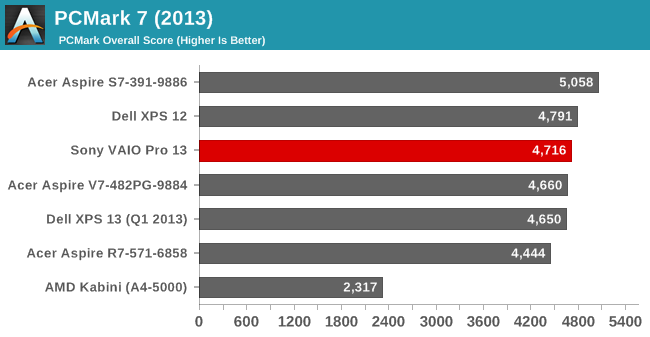
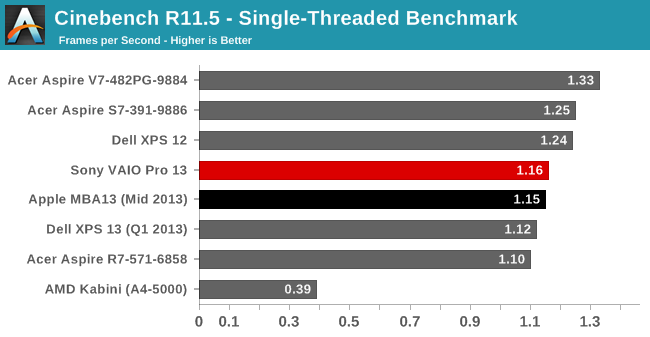
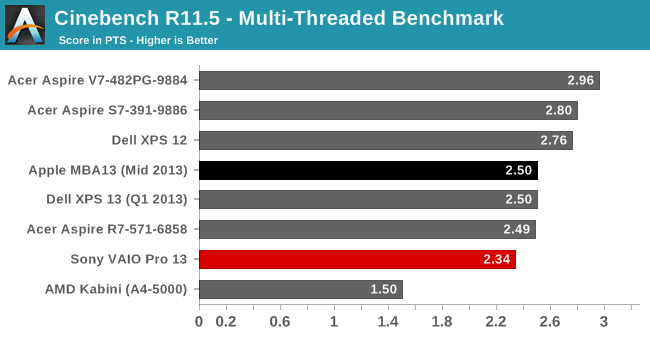
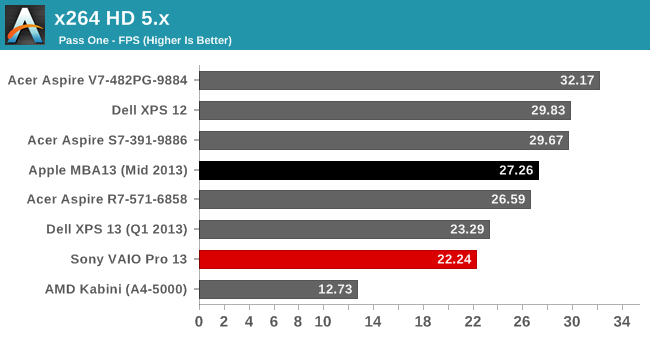
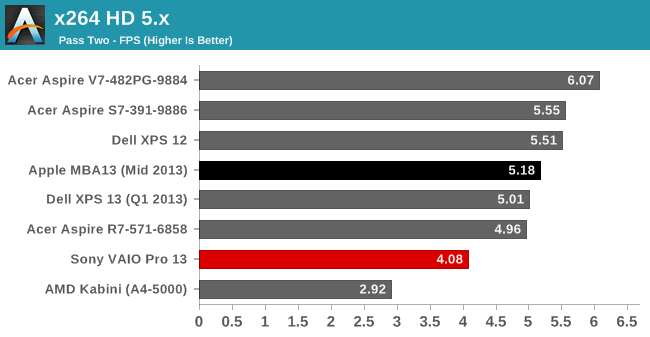
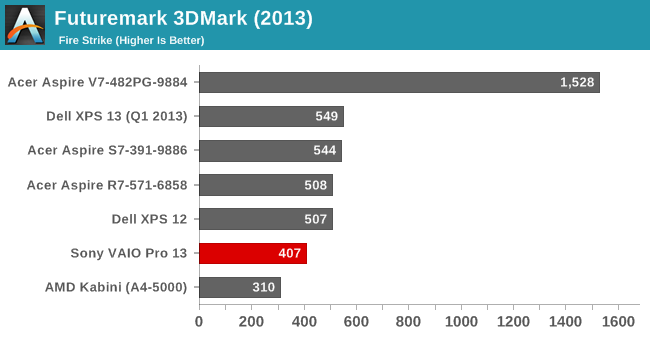
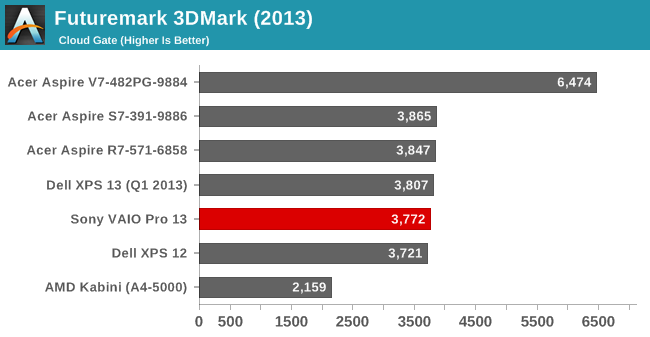
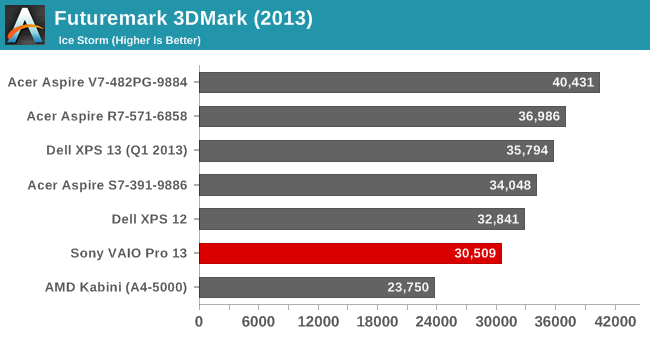
In our general performance graphs, here we get another results showing that Haswell isn't really any faster than Ivy Bridge in most tests (unless it has a GT3/GT3e iGPU, or in specific tests that leverage the new instructions). Move to the 3DMark results and the VAIO Pro 13 doesn't really look so hot. It's now clearly slower than the Core i7 Ivy Bridge Ultrabooks, which isn't something I'd expect from 20 EUs. Either Intel actually has slower EUs in Haswell than in Ivy Bridge, or Sony is curbing performance of the iGPU to keep within their desired thermal range. Our gaming results continue this trend:
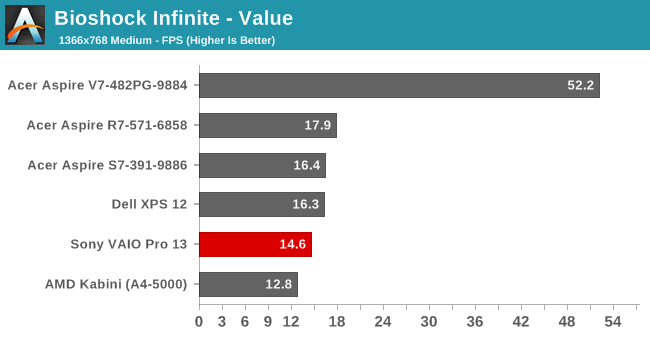

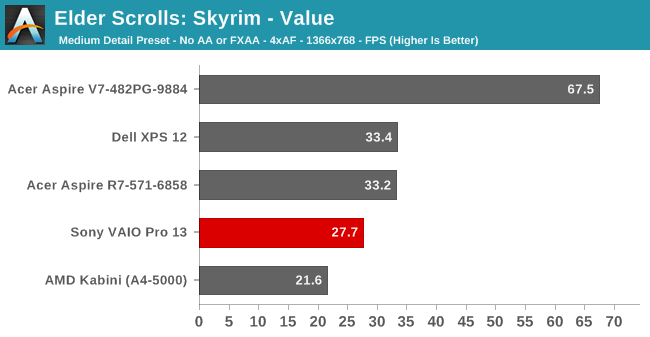
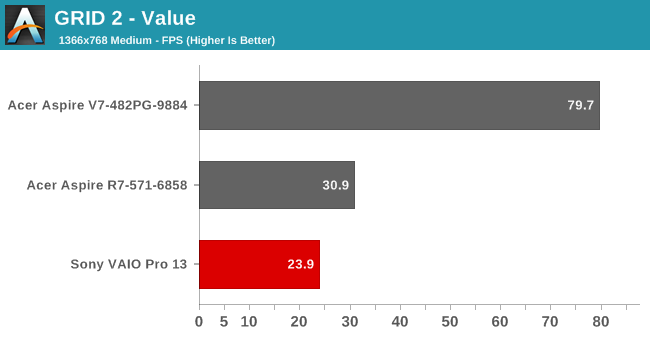
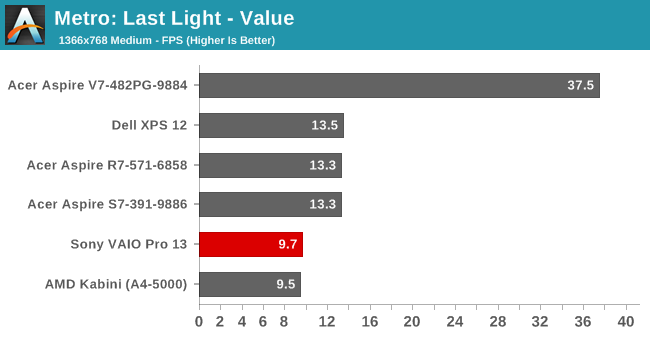
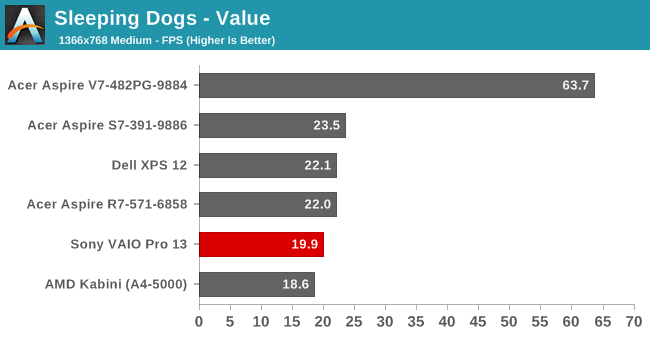
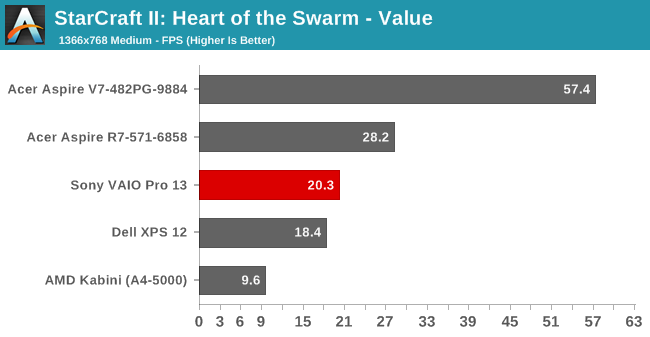
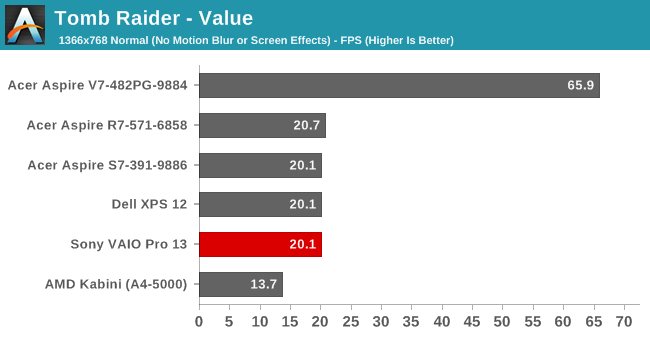
Other than in StarCraft II: Heart of the Swarm and Tomb Raider, the VAIO Pro 13 ends up being slower than every other Intel Ultrabook that we've tested. The Acer V7 isn't technically an Ultrabook, though it's close enough in many respects, but we can see just how much even a moderate dGPU adds in terms of performance. We also have some results for Crystalwell (i7-4750HQ) in Mobile Bench that we're not including here, and GT3e is much faster as well (though the Clevo W740SU doesn't do all that well in the battery life department). Perhaps GT3 would help the VAIO Pro 13, but several games seemed to have issues maintaining higher iGPU clocks – Metro for instance showed cyclic higher/lower performance during the benchmark runs. It's mostly a moot point, though, as outside of light gaming the HD 4400 simply isn't fast enough to handle a lot of games.










106 Comments
View All Comments
JarredWalton - Wednesday, October 16, 2013 - link
The battery life testing is all done automatically, so no scrolling. While that's not a perfect representation of how people use laptops, coming up with a way to simulate interaction with a laptop that's repeatable and consistent is far outside of our abilities. (No, I'm not going to sit in front of a laptop using the touchpad every minute or so for the duration of the battery tests -- especially not on laptops like this where it takes 15 hours to run down the battery in the Light test!)As for Min/Wh, of course it has meaning: it's how many minutes of battery life you'll get for every Watt-hour of battery capacity. Yes, we could convert that to simply "watts" if we wanted, but considering we're normalizing to battery capacity it makes more sense to me to keep that fact in the numbers. If we simply put "watts", someone is going to take that to mean we're actually measuring power draw in some fashion, when in reality I'm merely taking the battery life and dividing it by the capacity.
Put another way, you're smart enough to post the above comment asking about scrolling, so please don't pretend to be incapable of understanding the meaning behind "minutes per watt-hour". Saying it has "no meaning" would be like saying 1 Joule per second has no meaning... except that's what we now call a Watt (after James Watt). And of course Joule is named after James Prescott Joule, and it stands for the energy expended in applying a force of one Newton through a distance of one meter (or kg*m^2/s^2). Oh, and a Newton is named after Sir Isaac Newton, and represents kg * m / s^2. Whee! Maybe someday someone will come up with a name for Min/Wh -- I propose we call it a Walton. </sarcasm>
ananduser - Thursday, October 17, 2013 - link
Great review Jarred... I have some questions regarding battery life/testing.1. Which browsers are you using for Windows/OSX testing ? Native for each, IE/Safari, or crossplatform Chrome for both ? I trust that using the native solution for each platform is the most battery efficient option.
2. And at your normalization charts... specifically under full load... do you reckon that 1080p and the 1.6GHz might be the culprit behind lower efficiency compared to the MBA in the chart(with the lower CPU and the lower res)?
Thanks.
JarredWalton - Thursday, October 17, 2013 - link
Yes, Safari and IE (now IE10 with Win8) are used. I also use Windows Media Player for the music (which is more power friendly than the Windows Music App), but I switch to Media Player Classic - Home Cinema for the video. I don't know what Anand uses on OS X for the movies or music -- probably iTunes for music, and some standard video player?Regarding normalization, I think resolution may have a very small impact in some tests, possibly a larger impact for the 1080p video playback. I actually did some testing last year and found that Windows 8 seems to have leveled the playing field for 1080p video decoding though -- like, running a display at 1366x768 vs. 1080p had virtually no effect on battery life. That wasn't the case with Windows 7, so the new display driver model may have optimized some stuff in relation to video playback.
Anyway, it's difficult to say what the exact reason for the drop is at higher loads (the Heavy test), but since we're doing 8Mbps network stream + 1080p 12Mbps H.264 + fast web browsing there are a lot of parts in the system that will be active. My bet is that Apple just manages to keep things at lower power states better than Windows.
ajp_anton - Thursday, October 17, 2013 - link
I understand you don't want to manually scroll. I was just asking if you had some automatic scrolling figured out. No big deal though.As for units having meaning... what you just listed are standard units, and they all have their uses. A useless unit would be for example "furlongs per fortnight". It's a unit of speed, and you can make charts with it, showing you nicely how things compare relative to each other, but the numbers themselves would be meaningless and you might as well skip them altogether.
My point was that while your graph shows the relative power efficiency of the computers, which in itself is kind of interesting, the number "10" in "min/Wh" doesn't really say anything meaningful. It would be more interesting to know that the computer uses 6W.
How reliable that number is is another matter of course. Like you said, you're not measuring power, and so have to trust the battery capacity numbers, but I think it's still a better way to represent the same thing.
eamon - Saturday, October 19, 2013 - link
A note to the scrolling: I have the reviewed laptop, and I've noticed surprisingly high CPU usage in SynTPEnh.exe (I.e. the touchpad driver). I'd expect that to mean that any touchpad usage - even accidental contact which the touchpad driver (as mentioned in the review) filters out - will cause the CPU to burn power, reducing battery life.And in practice, I don't think I've achieved 8 hours of life (even just when web-browsing); sony's estimate of 6.5 hours seems more realistic.
In short: I think the comment about scrolling and touchpad usage is something that matters.
fokka - Wednesday, October 16, 2013 - link
seems i'm about on the same page as you, jarred, when it comes to ultrabooks. i too find 13" to be the sweet spot, but i'm still using my 2010 13-inch mpb, which already gets a bit old in the tooth, if i'm honest.i also like the zenbooks very much and am eagerly waiting for the upgraded version/s to arrive. i like some of sony's offerings, but their pricing and flexible, if not flimsy feeling hardware is just too much of a turn-off for me.
the metal finish of the zenbooks on the other hand is right up my alley and i'm hoping to get my hands on the new gorilla glass covered units as soon as possible, so i can form an opinion.
i'm looking forward to reading a review here!
Einy0 - Wednesday, October 16, 2013 - link
Looks a lot thicker than the Lenovo X1 Carbon...teiglin - Wednesday, October 16, 2013 - link
Just saw Lenovo's updated Yoga 2--13.3" 3200x1800. Best Buy sells a i5-4200U/128GB SSD/4GB RAM version for $1000 and Lenovo's site currently has the i5/256GB/8GB version for $1150. That's how pricing should be!JarredWalton - Thursday, October 17, 2013 - link
Dang, that's actually really impressive pricing from Lenovo. Sure, the Yoga 2 is a bit heavier than the VAIO Pro 13, and they currently have a sale going on, but when you can get 3200x1800 and 8GB RAM/256GB SSD for less than this Sony, I have to think that's the way to go.TheSSDReview - Thursday, October 17, 2013 - link
I am surprised that there wasn't any discussion on SSD types that could be found within the unit, especially since some configured systems contained much slower SATA M.2 SSDs, vice the Samsing native M.2 PCIe. We learned first hand and, whereas our first system contained a SSD capable of 500MB/s, the one we received yesterday (and posted on) reached 1GB/s with a 256GB Samsung. Would love to have seen some SSD results here as they are far and few in between and this is the most powerful storage performance ultra in the world right now, when received with the PCIe M.2. LOTS of unhappy customers who have received the SATA M.2 as well. Other than that nice system and nice review except for the continuous fan (always) and heat emmitted from the fan. I hope you dont mind but I think the storage performance differentiation is significant:SATA M.2 SSD: http://www.thessdreview.com/featured/sony-vaio-pro...
PCIe M.2 SSD: http://www.thessdreview.com/Forums/showthread.php?...